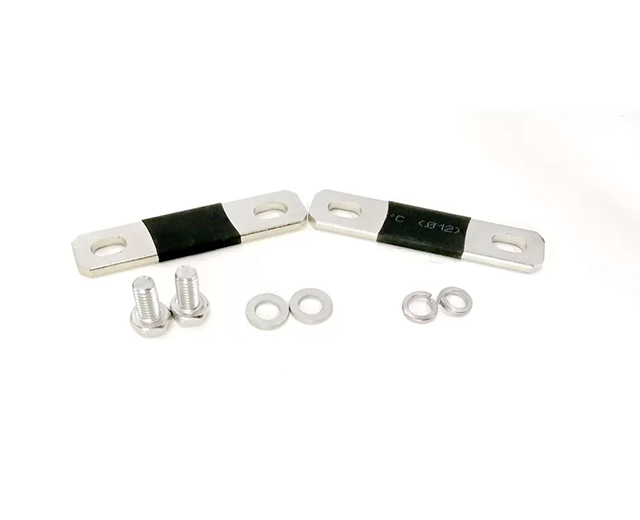2025-06-26 15:18:45
Battery bus bar connections are critical components in electrical power distribution systems, serving as conductive links between multiple battery cells or battery banks. These specialized connectors are designed to handle high current loads while maintaining low resistance and optimal thermal performance. Typically made from copper (99.9% pure) or aluminum alloys (6061-T6), bus bars provide a more reliable and efficient connection compared to traditional wiring solutions, especially in high-power applications.

High-quality battery bus bars exhibit exceptional electrical conductivity. Copper Bus Bars typically achieve 100% IACS (International Annealed Copper Standard) conductivity, with a resistivity of 1.724 μΩ·cm at 20°C. Aluminum alternatives offer slightly lower conductivity at 61% IACS, but with significant weight savings.
The current capacity of bus bars depends on their cross-sectional area and material. A standard 10mm × 3mm Copper Bus Bar can safely carry 150-200A continuously, with short-term surge capacity up to 300A for 30 seconds. Proper sizing is crucial to prevent overheating, with temperature rise typically limited to 30°C above ambient under full load.
Bus bars must effectively dissipate heat generated by I²R losses. Copper's thermal conductivity of 401 W/(m·K) outperforms aluminum's 237 W/(m·K), but both materials require proper spacing and ventilation in enclosure designs. Advanced designs may incorporate thermal imaging markers for easy monitoring.
Bus bar mechanical strength is vital for vibration resistance. Copper bus bars typically have a tensile strength of 200-250 MPa, while aluminum alloys range from 110-310 MPa depending on temper. Proper torque specifications for connections range from 5-25 Nm depending on bolt size and material.
Surface treatments significantly enhance durability. Common options include tin plating (5-10μm thickness), silver plating (3-8μm), or anodization for aluminum. These treatments maintain contact resistance below 50μΩ even after 1000+ thermal cycles.
Modern EV battery packs utilize bus bars to connect hundreds of lithium-ion cells. Tesla's Model S battery module, for instance, uses 0.8mm thick, 25mm wide copper bus bars with laser-welded connections capable of handling 1000A peak currents. The low resistance (<0.1mΩ per connection) is critical for maximizing range.
Grid-scale battery installations rely on bus bars for their scalability and reliability. A 1MWh containerized ESS might use 50mm × 10mm Aluminum Bus Bars to interconnect battery racks, reducing voltage drop to <0.5% across the entire system while withstanding 6000+ charge/discharge cycles.
Uninterruptible power supplies for data centers employ bus bars rated for 500-5000A continuous operation. These often feature modular designs with IP65-rated insulation and may include integrated Hall-effect current sensors for real-time monitoring.
Solar-plus-storage installations use bus bars to combine power from multiple sources. Specialized designs accommodate 1500VDC systems with creepage distances exceeding 25mm to prevent arcing in humid conditions.
Weight-sensitive applications favor aluminum bus bars with 63% weight reduction versus copper. Aerospace-grade versions meet MIL-DTL-38999 specifications for vibration resistance, surviving 10-2000Hz random vibration profiles at 0.04g²/Hz.
Implement a quarterly inspection protocol checking for:
Visual signs of oxidation (green patina on copper, white powder on aluminum)
Thermal discoloration indicating hot spots (use infrared thermography at 30-100μm spectral range)
Torque verification using calibrated tools (re-torque to ±10% of spec after first 100 hours)
For contaminated connections:
De-energize the system completely
Use non-abrasive fiber brushes (0.1mm bristles) with isopropyl alcohol (99.9% purity)
Apply NO-OX-ID A-Special or equivalent antioxidant compound (0.1mm coating thickness)
Perform annual micro-ohm measurements:
Use a 4-wire Kelvin measurement at 10A test current
Compare to baseline readings - replace if resistance increases by >20%
Document results with ambient temperature compensation (0.4%/°C for copper)
Ensure proper cooling:
Maintain ≥10mm air gaps between parallel bus bars
Clean ventilation paths to limit temperature rise to <40°C above ambient
For forced air systems, verify 2-5 m/s airflow velocity across surfaces
In harsh environments:
Apply conformal coating (50-100μm) to non-contact surfaces
For marine use, specify CuNi90/10 alloy bus bars with >5000 hours salt spray resistance
Install humidity indicators (30-60% RH range) in enclosures
Note: Always follow manufacturer-specific maintenance guidelines, as proprietary designs may have unique requirements. For example, some lithium-ion battery systems specify torque-to-yield fastener procedures that shouldn't be re-torqued.